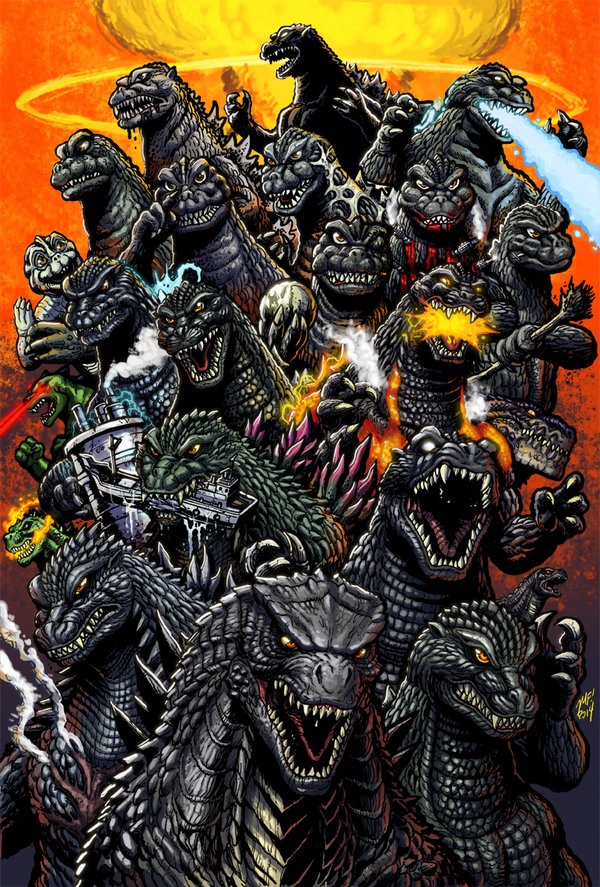 by Troy Tue Sep 20, 2016 4:58 pm
by Troy Tue Sep 20, 2016 4:58 pm
Crap I am running out of things to say on this matter... I admit defeat!Moving along, now it time to go back to 2005.
Read this in a BBC nature documentary narrator voice.
The biggest predator on Skull Island was the Vastatosaurus rex (Ravager-lizard king). Like their prehistoric Tyrannosaur relations, the Skull Island V. rexes had little competition for their spot as top predators. In spite of their size, they could turn a surprising burst of speed for short periods. Clocking up to 25 MPH for limited stretches in pursuit of prey. V. rexes developed many unique features over the sixty-five million years since the age of the dinosaurs, but they bore several recognizable similarities to their Cretaceous ancestors.
V. rexes had large heads, filled with long teeth that were constantly being regrown to replace those lost in conflict. Their heads were intensely reinforced with heavy bone. As a primary weapon of the animal, an individual Vastatosaurus' head was often distinctive, being covered in scars and calluses. Abnormal bone growths formed from old battles with prey, other predators, rivals, or even mates. Narrow, short rib cages and a large gap between the ribs and hips allowed V. rexes surprising flexibility for animals their size, a necessary adaption to the broken terrain of Skull Island. Their Forelimbs were small in comparison with the rest of their bodies, not growing as fast as the rest of the animal so the adulthood this disparity in spite of their size was strikingly evident. Early Tyrannosauroids had only two fingers on their forelimbs, but Skull Island V. rexes had three. When dragging carcasses, the tiny arms helped pin the meat against the body and prevent it swinging around.
While juvenile V. rexes tended to cluster in the thick jungle interior, the large adults hunted mostly in the open areas of the lowlands where they could move freely. large bulls sought the most open territories while mature females usually staked claim to areas of the fringes of the thicker forests where they could find hidden nesting sites. Fiercely territorial, adult V. rexes suffered no rival encroachment on their hunting grounds. Territorial boundaries were regularly marked with urine, and dawn roaring would reinforce claims to land. Neighbors could tell much about the physical condition of the owner of a territory from the smell of its urine and the sound of a roar. Displays and scenting minimized potentially dangerous confrontations between animals of different sizes. Occasionally disputes between evenly matched V. rexes would erupt. With the threat of serious injury, these confrontations were usually resolved with intense roaring matches in which each animal attempted to intimidate the other into giving away. However, when this failed, violence ensued. Older V. rexes bore the crisscrossing of many fights.
Exceptions to their solitary existence were made in the breeding season. Males would leave their hunting grounds to seek out females in season. If the female was receptive, she would accept the bull, and the couple might stay together, hunting in her territory for several days before she tired of him and sent him on his way. Adolescent V. rexes-seeking to hone their hunting skills-would sometimes follow adults at a safe distance during the mating season, watching and occasionally stealing meals from unguarded kills. Taking advantage of the season of nomadic adult males, bold adolescents might move in to claim currently undefended territory as their own.
V. rexes were capable of tackling very large prey species, but their massive size was often employed to intimidate smaller carnivores into giving up their kills. While effective hunters, a meal was safer to obtain by simply appropriating someone else's carcass. V. rexes had intently acidic stomachs, capable of processing even the most rancid rotting meat, a feature that served the species well as heavyweight scavengers. Their massive jaws could exert astounding pressure, shattering bones to expose the rich marrow less robust predators were unable to reach. As hunters, Skull Island's V. rexes tended to employ ambush tactics, using cover in and around waterholes or forested areas to surprise prey. Ligocristus were the primary prey of adult V. rexes, being the most abundant. Ferructus and Brontosaurus were more dangerous prospects; however, if a young or sick animal could be separated from the protection of the herd it could ne an easy kill. Any smaller species were likely game, though most were too small to provide more than a snack. The greatest challenge for the hunter lay in not being spotted by prey. Adult V. rexes were dark in coloring and, despite their size, could be surprisingly stealthy, using shadows near the fringes of scrub, rocky outcroppings, or ruins to hide their approach. Their black scales also aided V. rexes in warming up quickly in the mornings, boosting their energy levels to gain an advantage over still sluggish herbivores.


























